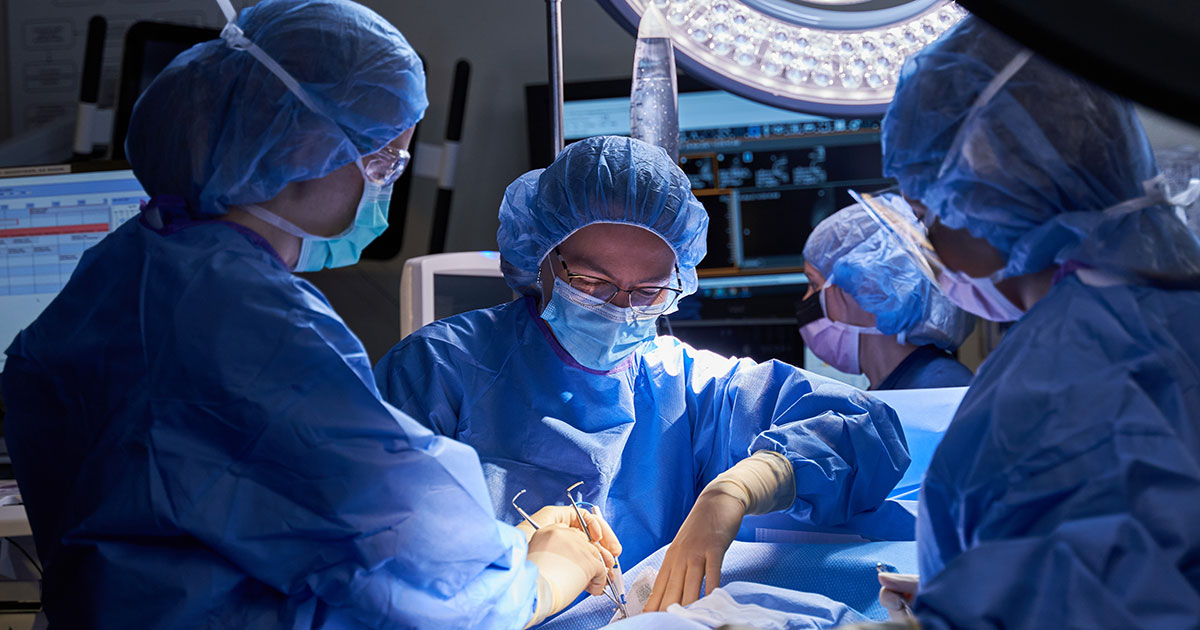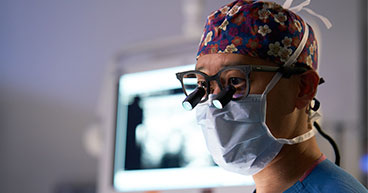
As a breast surgeon, I believe it’s my job—and the job of every provider—to approach treatment with the whole patient in mind. That’s why I give my patients every available option when a breast is surgically removed during cancer treatment, a procedure called a mastectomy.
In general, we have two options after a mastectomy:
- We can close the incision and skin over the chest wall—what’s now commonly referred to as “going flat.”
- We can rebuild a new breast for patients, which is called breast reconstruction.
For some patients, having a breast mound is part of how they identify as women. However, performing breast reconstruction involves an additional surgery, which may double the amount of time spent in the operating room. Depending on the patient, the reconstruction portion of the cancer surgery may involve prolonged healing and recovery times, an increased risk for surgical complications and additional procedures or surgeries in the future.
Alternatively, some women may decide to choose a “one-and-done” path, which may mean less risk, fewer post-surgical complications—both early and in the future—and the potential for a shorter recovery time. Eliminating breast reconstruction surgery and going flat is a way for women to reduce risks and complications while getting back faster to activities they love.
In fact, in recent years, advocacy groups and online communities have been popping up as part of the going-flat movement to increase awareness and acceptance of mastectomy without reconstruction.
The correct decision is whatever’s best for the patient. No two cancers are alike, which means one woman’s cancer journey may look very different from her family members’ or friends’.
In this article, we’ll explore:
If you’ve been diagnosed with breast cancer and are interested in a second opinion on your diagnosis and treatment plan, call us or chat online with a member of our team.
Post-mastectomy options
While considering the personal decision to undergo breast reconstruction or to go flat after a mastectomy or double mastectomy, it’s important that patients make an informed decision. They also need to know that going flat doesn’t mean they have to go without.
Today, boutiques all over the country sell breast prosthetics, bras, wigs and other attire for women who’ve undergone a mastectomy and chosen to go flat. That includes swimsuits designed specifically for women who’ve had breast cancer surgery.
Patients should also know that most women who opt for a mastectomy without reconstruction are satisfied with the results—nearly 75 percent of women, in fact, according to a 2021 online survey. Some of the most common reasons women say they chose to go flat include:
- Not wanting a foreign object—in this case, a breast implant—in the body
- A desire for a lower risk of surgical complications and other health problems
Still, almost 25 percent of women who chose to go flat say their decision was not supported by their doctor—what’s known as “flat denial.” Many reported waking up from surgery to find their surgeon left extra skin in the breast area in case they changed their mind and wanted breast reconstruction, even though that’s not what they’d discussed.
What is aesthetic flat closure?
If you’re thinking of going flat, it’s important to talk to a surgeon who has experience performing aesthetic flat closure, which is the medical term adopted by the National Cancer Institute in 2020 for surgery that removes extra skin, fat and other tissue in the breast area after mastectomy and then tightens and smooths the remaining tissue so the chest wall looks flat.
Also called post-mastectomy chest wall reconstruction, aesthetic flat closure is considered the gold standard for going flat. It means you can live flat all the time or choose to use external breast forms, or breast prostheses, as often as you wish. These breast forms can help restore the appearance of having breasts when women are clothed.
Recovering from aesthetic flat closure is typically easier than recovering from breast reconstruction. Reconstruction surgery often requires at least two procedures to achieve the desired result, sometimes more.
Some women making the decision between breast reconstruction and going flat after a mastectomy may worry about sexual arousal and intimacy if they choose aesthetic flat closure. But sex after mastectomy with aesthetic flat closure may be just as fulfilling as it was before surgery. To learn more and for peace of mind, you may find it helpful to talk with a sexual health therapist who works with breast cancer patients about your concerns.
How to make a post-mastectomy decision
Your decision to undergo reconstruction or go flat is yours and yours alone. It’s important to find a surgeon who listens to you and respects your choice.
Make sure you’re upfront with your surgeon about what you want. Bring in pictures of the results you’re looking for, and don’t hesitate to get a second opinion, especially if your doctor doesn’t offer going flat as one of your options. If your surgeon doesn’t have experience performing aesthetic flat closures, you may want to ask whether it’s possible to bring in a plastic surgeon who has experience with the procedure.
Some questions to consider asking a potential surgeon include:
- Have you performed an aesthetic flat closure? If so, can I see pictures of your work?
- Is there anything about my anatomy (large breasts, weight or body type) that’ll make achieving a successful aesthetic flat closure challenging for you? If so, how do you plan to overcome that challenge?
- What if radiation therapy affected the skin and tissue quality in my breasts? Will that be a problem?
- How will you avoid so-called “dog ears” (bulges of extra skin under the arms)?
- Do you think I’ll need a second procedure to get the desired result? What can I expect in that case?
- If I decide to pursue breast reconstruction after an aesthetic flat closure, what are my options?
- Where will I have scars after the surgery?
The last question is important if you’re considering covering your scars with a tattoo once they’ve healed. Women who go flat sometimes choose to decorate their post-mastectomy chests with tattoos that camouflage the scar or resemble a nipple and areola.
Plenty of resources and support are available for women considering going flat. The advocacy group Not Putting on a Shirt, for example, offers a comprehensive guide to living flat, as well as offering a directory of surgeons who perform aesthetic flat closure.
The most important thing is to make an informed decision that’s right for you—and that you’ll be happy with in the years to come. But if you do change your mind down the road, you shouldn’t have trouble going from flat to reconstructed or from reconstructed to flat. Just talk with your surgeon to make sure you’ll have the option in the future.
If you’re interested in getting screened for cancer or if you’ve been diagnosed with cancer and want a second opinion, call us or chat online with a member of our team.
A version of this article was originally published in Curetoday.com.


